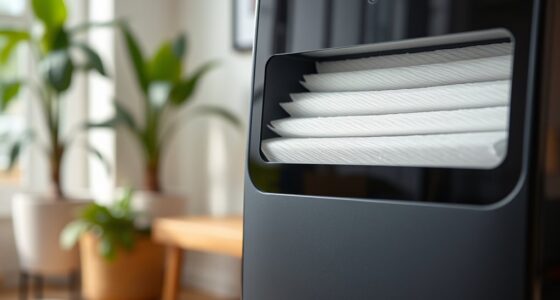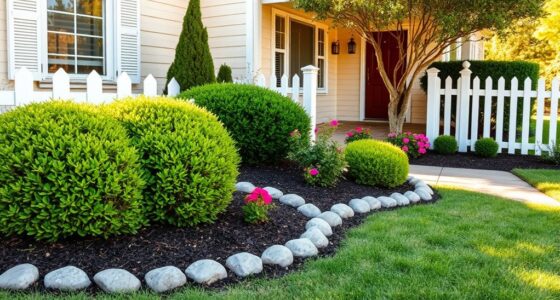To upgrade your smart home in 2025, start by adding voice control devices like smart speakers for hands-free management of lights, thermostats, and appliances, making tasks effortless. Focus on energy efficiency tools that help you monitor usage and reduce waste, such as smart thermostats and energy monitors. Confirm your devices are compatible with platforms like Alexa or Google Assistant for seamless control. Exploring these simple upgrades could transform your home—keep going to discover more ideas for a smarter living space.
Key Takeaways
- Integrate voice control devices like smart speakers for hands-free management of lights, thermostats, and appliances.
- Upgrade to smart lighting systems with voice activation for customizable ambiance and energy savings.
- Install smart thermostats to remotely control and automate temperature settings, enhancing comfort and efficiency.
- Add smart security cameras and doorbells for real-time monitoring and enhanced home safety.
- Use energy monitoring tools to track consumption, identify waste, and optimize usage with voice-activated controls.

Have you ever wondered how smart homes make daily life easier? One of the biggest reasons is the seamless integration of voice control. With just a simple command, you can turn on the lights, adjust the thermostat, or play your favorite music without lifting a finger. Voice control technology has become incredibly intuitive, allowing you to manage your home hands-free. As you speak, smart devices interpret your commands accurately, making everyday tasks faster and more convenient. Plus, many systems can recognize different voices, so each family member can have personalized settings without hassle.
Smart homes use voice control for effortless, hands-free management of devices and personalized settings.
Beyond convenience, voice control plays an essential role in enhancing energy efficiency. When you can effortlessly turn off unused appliances or dim the lights with a quick voice command, you’re less likely to forget these actions. This means you use energy more deliberately, which not only reduces your utility bills but also helps protect the environment. For example, you might say, “Goodbye, lights,” as you leave the room, and the system will switch everything off automatically. Similarly, adjusting your thermostat with your voice ensures you’re not wasting energy heating or cooling an empty house. Over time, these small, smart adjustments can lead to significant savings and a more eco-friendly lifestyle.
Implementing voice control is straightforward, and many devices are compatible with popular smart home platforms like Alexa, Google Assistant, or Siri. You can start with simple gadgets, such as smart speakers or voice-activated lights, then expand to more complex systems like automated blinds or security cameras. The key is to choose devices that mesh well with your existing setup and suit your daily routines. Once installed, you’ll find yourself relying on voice commands more often, making your home feel more responsive and tailored to your needs.
Energy efficiency benefits go beyond just comfort and savings. Smart homes equipped with voice control also enable better monitoring of energy use. You can ask your system for real-time updates on how much power your appliances are consuming, helping you identify areas where you can cut back. Over time, these insights encourage smarter habits, like running laundry during off-peak hours or turning off devices when not in use. This proactive approach not only saves money but also contributes to a greener planet. Additionally, using airless paint sprayers can streamline home improvement projects, ensuring quick and even coverage with less effort—making smart upgrades even more effective for a modern home.
Frequently Asked Questions
How Secure Are Smart Home Devices Against Hacking?
Smart home devices are generally secure if you focus on device encryption and hacking prevention. You should keep software updated, use strong, unique passwords, and enable two-factor authentication whenever possible. Regularly review device security settings and disconnect unused devices. While no system is completely invulnerable, these steps considerably reduce your risk of hacking, helping you enjoy the convenience of smart devices with peace of mind.
Can Smart Upgrades Increase My Home’s Energy Efficiency Significantly?
Yes, smart upgrades can boost your home’s energy efficiency considerably. By using energy savings features and appliance automation, you can optimize heating, cooling, and lighting, reducing waste and lowering utility bills. Smart thermostats learn your schedule, while automated lighting turns off when not in use. These upgrades make managing energy simple and effective, helping you save money and reduce your carbon footprint effortlessly.
Are Smart Home Devices Compatible With All Existing Home Systems?
You might worry about device integration challenges, but most smart home devices are designed for broad home system compatibility. While some older systems could pose issues, many new devices easily connect through common standards like Wi-Fi, Zigbee, or Z-Wave. Before purchasing, check compatibility details to guarantee seamless incorporation. With a little planning, you’ll enjoy the convenience of smart upgrades without frustration or extra hassle.
What Is the Average Cost of Smart Home Upgrades in 2025?
In 2025, the average cost of smart home upgrades varies based on the devices you choose, but generally, you can expect to spend between $100 and $500 per upgrade. Pricing trends show that as technology advances, upgrade costs are gradually decreasing, making smart home devices more accessible. You’ll find affordable options for lighting, security, and thermostats, allowing you to enhance your home without breaking the bank.
How Do I Choose the Right Smart Home Gadgets for My Needs?
You should start by identifying your user preferences, such as automation, security, or energy savings. Look for smart home gadgets that offer seamless device integration with your existing systems. Read reviews to gauge compatibility and ease of use. Consider your budget and future upgrades. Ultimately, choose devices that align with your needs and can easily connect with other gadgets, making daily routines more convenient and efficient.
Conclusion
Think of your smart home as a garden—each upgrade is a seed you plant today, promising a thriving, effortless oasis tomorrow. With simple upgrades like smart lights or thermostats, you’re nurturing a landscape of convenience and comfort. As you tend to these seeds, your home blossoms into a sanctuary that responds to your needs. Embrace these easy changes in 2025, and watch your smart home flourish into a haven uniquely tailored for you.









